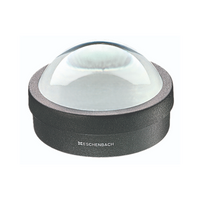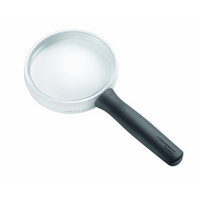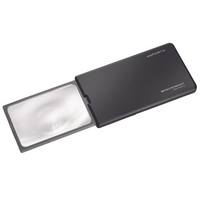Hand-held magnifying glasses are a great way for people with low vision to enlarge text and images. However, with so many different types of lenses available, it can be difficult to know which one is right for you.
Plano-convex Lenses

Plano-convex lenses have one flat surface and one convex surface. They are the simplest and most common type of lens used in magnifiers. Plano-convex lenses provide a sharp image at the center of the field of view, but the image may be distorted at the edges.
A great example of a plano-convex magnifier is the Bright Field 1.8x from Eschenbach; which has a 1.8x magnification strength and a 2.55-inch lens diameter, making it ideal for magnifying small text and images.
Biconvex Lenses
Biconvex lenses have two convex surfaces. They provide a wider field of view than plano-convex lenses, but the image may be more distorted. Biconvex lenses are also thicker and heavier than plano-convex lenses.
You can find sizes ranging from small folding pocket magnifiers, to larger hand-held magnifiers like the Large Field biconvex from Eschenbach.
Aplanatic Lenses

Aplanatic lenses are made up of two plano-convex lenses that are placed face-to-face. They provide a sharp image across the entire field of view, with minimal distortion. Aplanatic lenses are the most expensive type of lens used in magnifiers, but they are also the best option for people who need a magnifier that provides a clear and distortion-free image.
A good example is the ERGO hand-held aplanatic magnifier from Eschenbach (pictured here); which is available in magnifications from 2.4x to 4.5x.
Aspheric Lenses

Aspheric lenses have a curved surface that is not perfectly spherical. This allows them to provide a sharp image across the entire field of view, with minimal distortion. Aspheric lenses are less expensive than aplanatic lenses, but they are still more expensive than plano-convex and biconvex lenses.
You can find aspheric lenses in everything from lamp magnifiers to pocket magnifiers like the Eschenbach EasyPocket XL.
Which type of lens is right for you?
The best type of lens for you will depend on your individual needs and preferences. If you are looking for a magnifier that is affordable and easy to use, then a plano-convex or biconvex lens may be a good option for you. If you need a magnifier that provides a clear and distortion-free image, then an aplanatic or aspheric lens may be a better choice.
Here are some specific examples of how each type of lens can help someone with low vision:
- Plano-convex lenses: Plano-convex lenses are a good choice for people who need to magnify small text or images, such as those found in books, newspapers, and magazines.
- Biconvex lenses: Biconvex lenses are a good choice for people who need to magnify larger areas, such as maps, menus, and signs.
- Aplanatic lenses: Aplanatic lenses are a good choice for people who need a magnifier that provides a clear and distortion-free image, such as those who have macular degeneration.
- Aspheric lenses: Aspheric lenses are a good choice for people who need a magnifier that is lightweight and portable, such as those who travel frequently.
If you are not sure which type of lens is right for you, it is a good idea to consult with a low vision specialist. They can assess your needs and help you choose the best magnifier for your individual situation.




